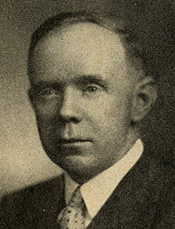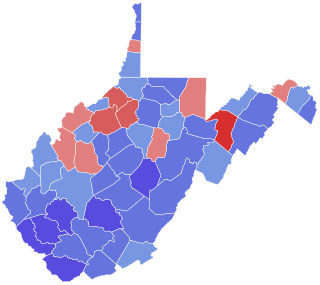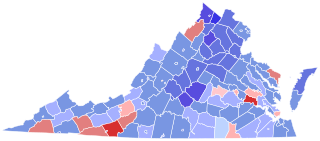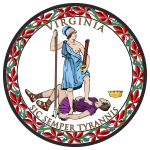
The 2000 United States House of Representatives elections on November 7, 2000 coincided with the election of George W. Bush as President of the United States. The Republican Party won 221 seats, while the Democratic Party won 212 and independents won two. Although there was minor seat change, this year was the highest percentage for the Libertarian Party in The House of Representatives and the last time that independents gained a seat.

Francis Johnson Love was an American politician and Republican U.S. Congressman from West Virginia; born in Cadiz, Harrison County, Ohio, on January 23, 1901. He attended public schools, then attended Bethany College in Bethany, West Virginia, where he received an A.B. degree in 1924.

The United States House of Representatives elections in California, 1966 was an election for California's delegation to the United States House of Representatives, which occurred as part of the general election of the House of Representatives on November 8, 1966. Republicans gained three seats from the Democrats. There was a mid-decade redistricting of the California districts in 1966.

The 1966 United States Senate election in West Virginia was held on November 8, 1966. Incumbent Democratic U.S. Senator Jennings Randolph won re-election to a third term.

The 1994 United States House of Representatives elections in Virginia were held on November 8, 1994 to determine who will represent the Commonwealth of Virginia in the United States House of Representatives. Virginia has eleven seats in the House, apportioned according to the 1990 United States Census. Representatives are elected for two-year terms.

The 1932 United States House of Representatives elections in Virginia were held on November 8, 1932 to determine who will represent the Commonwealth of Virginia in the United States House of Representatives. Representatives are elected for two-year terms. Virginia had only nine seats in the House, losing a seat due to re-apportionment following the 1930 United States Census. This election was unique because all representatives were elected at-large instead of the previously used electoral district system. However, this idea was not popular and the state returned to using electoral districts in the next election.

The 1938 United States House of Representatives elections in Virginia were held on November 8, 1938 to determine who would represent the Commonwealth of Virginia in the United States House of Representatives. Virginia had nine seats in the House, apportioned according to the 1930 United States Census.

The 1946 United States House of Representatives elections in Virginia were held on November 5, 1946 to determine who will represent the Commonwealth of Virginia in the United States House of Representatives. Virginia had nine seats in the House, apportioned according to the 1940 United States Census. Representatives are elected for two-year terms.

The 1950 United States House of Representatives elections in Virginia were held on November 7, 1950 to determine who will represent the Commonwealth of Virginia in the United States House of Representatives. Virginia had nine seats in the House, apportioned according to the 1940 United States Census. Representatives are elected for two-year terms.

The 1988 United States House of Representatives elections in Virginia were held on November 8, 1988 to determine who will represent the Commonwealth of Virginia in the United States House of Representatives. Virginia had ten seats in the House, apportioned according to the 1980 United States Census. Representatives are elected for two-year terms.

The 1964 United States House of Representatives elections in Virginia were held on November 3, 1964 to determine who will represent the Commonwealth of Virginia in the United States House of Representatives. Virginia had ten seats in the House, apportioned according to the 1960 United States Census. Representatives are elected for two-year terms.

The 1962 United States House of Representatives elections in Virginia were held on November 6, 1962 to determine who will represent the Commonwealth of Virginia in the United States House of Representatives. Virginia had ten seats in the House, apportioned according to the 1960 United States Census. Representatives are elected for two-year terms.

The 1960 United States House of Representatives elections in Virginia were held on November 8, 1960 to determine who will represent the Commonwealth of Virginia in the United States House of Representatives. Virginia had ten seats in the House, apportioned according to the 1950 United States Census. Representatives are elected for two-year terms.

The 1966 United States Senate election in Virginia was held on November 8, 1966. Democratic State Senator William Spong Jr. defeated Republican James Ould and Independent F. Lee Hawthorne. This was the last time a Democrat won the Class II senate seat from Virginia until 2008. The election was held on the same day as a special election for Virginia's other United States Senate seat.

The 1966 United States Senate special election in Virginia was held on November 8, 1966, alongside the other U.S. Senate election in Virginia. Incumbent Senator Harry F. Byrd Sr. had retired the previous year due to health reasons, and his son Harry F. Byrd Jr. had been appointed to replace him. Byrd defeated Republican Lawrence M. Traylor and independent candidate John W. Carter, and was able to finish the balance of his father's sixth term.

The 2016 United States House of Representatives elections in West Virginia were held on November 8, 2016, to elect the three U.S. representatives from the state of West Virginia, one from each of the state's three congressional districts. The elections coincided with the 2016 U.S. presidential election, as well as other elections to the House of Representatives, elections to the United States Senate and various state and local elections.

The 1940 United States House of Representatives elections in Virginia were held on November 5, 1940 to determine who will represent the Commonwealth of Virginia in the United States House of Representatives. Virginia had nine seats in the House, apportioned according to the 1930 United States Census. Representatives are elected for two-year terms.

The 1936 United States House of Representatives elections in Virginia were held on November 3, 1936 to determine who will represent the Commonwealth of Virginia in the United States House of Representatives. Virginia had nine seats in the House, apportioned according to the 1930 United States Census. Representatives are elected for two-year terms.

The 1934 United States House of Representatives elections in Virginia were held on November 6, 1934 to determine who will represent the Commonwealth of Virginia in the United States House of Representatives. Virginia had nine seats in the House, apportioned according to the 1930 United States Census. Representatives are elected for two-year terms. This election was notable for the state's return to electoral district voting after briefly experimenting with electing all Representatives at-large in the previous election.

The 1968 Arkansas gubernatorial election was held on November 5, when incumbent Republican Winthrop Rockefeller defeated former Speaker of the Arkansas House of Representatives Marion Crank by a small margin. Rockefeller was firstly elected in 1966, becoming the first Republican governor of the state since the end of Reconstruction. As of 2022, this is the last time that St. Francis County has voted for the Republican candidate in a presidential election.









